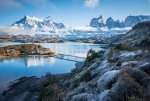Although the days have been getting noticeably longer since we arrived in Japan, this was quite a long riding day and we pulled into the city of Miyazaki well after sunset. We haven't booked any hotel or AirBnB yet, plus we are starving (!), having eaten nothing since a late breakfast.
Just as we cross into the city limits, we see a large lit sign by the side of the road with pictures of well-marbled red meat! Yes! We are totally in the mood for meat! Also, we can sit down in a warm restaurant and try to find a place to sleep tonight.
Usually we would have taken the time to search for a cheap Japanese chain restaurant, like a Yoshinoya or Coco Curryhouse, but today is a special day. It's Neda's birthday, so we are treating her to a nice dinner! Fifth birthday on the road!

Taking our shoes/boots off is a regular ritual before entering any building in Japan. Once we're in, we treat ourselves to a meat fest!
You can see Neda is straightening her chopsticks the proper Japanese way - with two hands. She is so nerdy that way...
Yakiniku is Japanese BBQ. It's heavily borrowed from the Korean BBQ restaraunts where they bring you plates of raw meat and you cook it yourself over a personal grill set in the middle of the table. It's not really traditional as Yakiniku only came to Japan after WWII, but it's very popular here, especially in Miyazaki because they are known for their Wagyu beef in this prefecture.
What is Wagyu beef? It's a special way of breeding cattle so they have lots of marbled fat in the meat. VERY TASTY! But very expensive. We only ordered a small plate to taste (it was delicious!), and had regular meat and seafood to fill ourselves up. I've heard Wagyu cattle get regular massages by Japanese women and then are fed a steady diet of beer to raise their fat content, but wikipedia says this is a myth. That's too bad, because massages and beer totally sounds like a place I could stay at for awhile. Um... minus the slaughter at the end of the stay, I guess...
Just as we cross into the city limits, we see a large lit sign by the side of the road with pictures of well-marbled red meat! Yes! We are totally in the mood for meat! Also, we can sit down in a warm restaurant and try to find a place to sleep tonight.
Usually we would have taken the time to search for a cheap Japanese chain restaurant, like a Yoshinoya or Coco Curryhouse, but today is a special day. It's Neda's birthday, so we are treating her to a nice dinner! Fifth birthday on the road!

Taking our shoes/boots off is a regular ritual before entering any building in Japan. Once we're in, we treat ourselves to a meat fest!
You can see Neda is straightening her chopsticks the proper Japanese way - with two hands. She is so nerdy that way...
Yakiniku is Japanese BBQ. It's heavily borrowed from the Korean BBQ restaraunts where they bring you plates of raw meat and you cook it yourself over a personal grill set in the middle of the table. It's not really traditional as Yakiniku only came to Japan after WWII, but it's very popular here, especially in Miyazaki because they are known for their Wagyu beef in this prefecture.
What is Wagyu beef? It's a special way of breeding cattle so they have lots of marbled fat in the meat. VERY TASTY! But very expensive. We only ordered a small plate to taste (it was delicious!), and had regular meat and seafood to fill ourselves up. I've heard Wagyu cattle get regular massages by Japanese women and then are fed a steady diet of beer to raise their fat content, but wikipedia says this is a myth. That's too bad, because massages and beer totally sounds like a place I could stay at for awhile. Um... minus the slaughter at the end of the stay, I guess...




























































